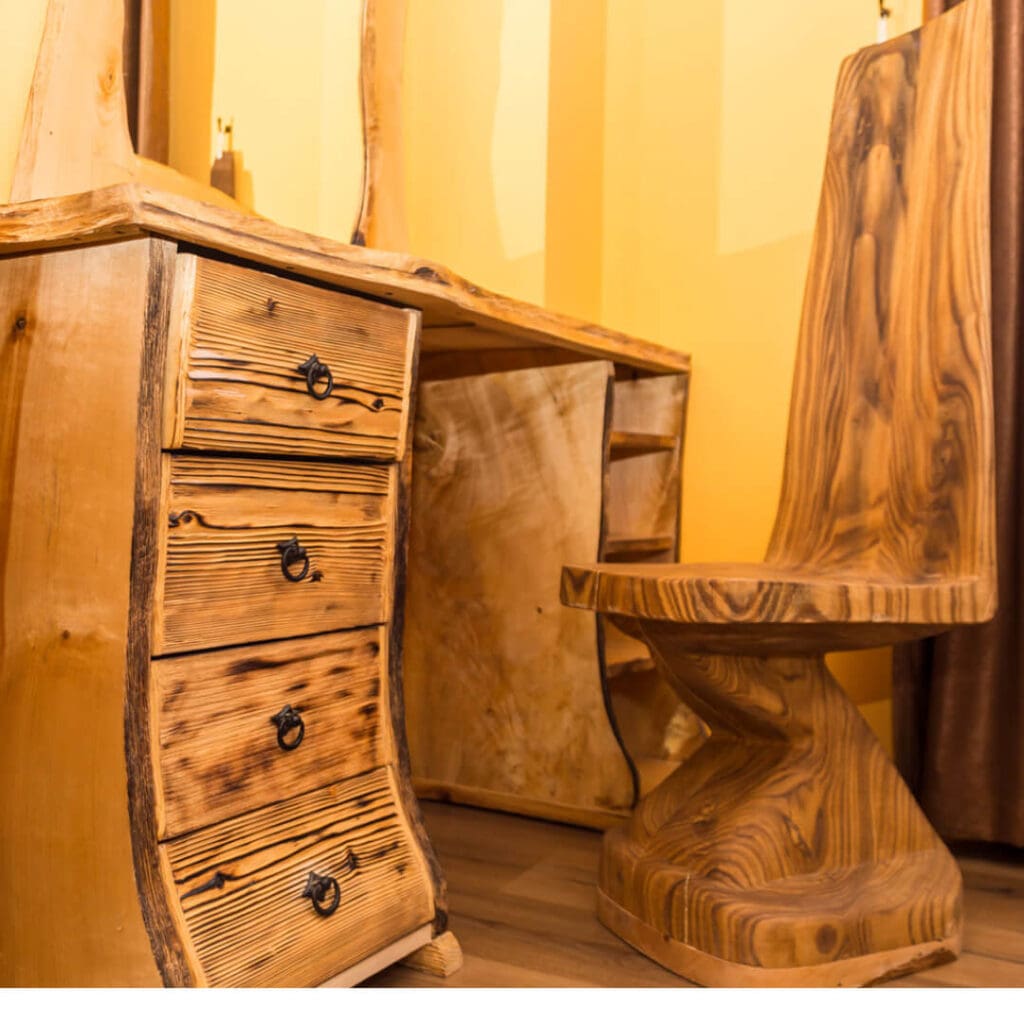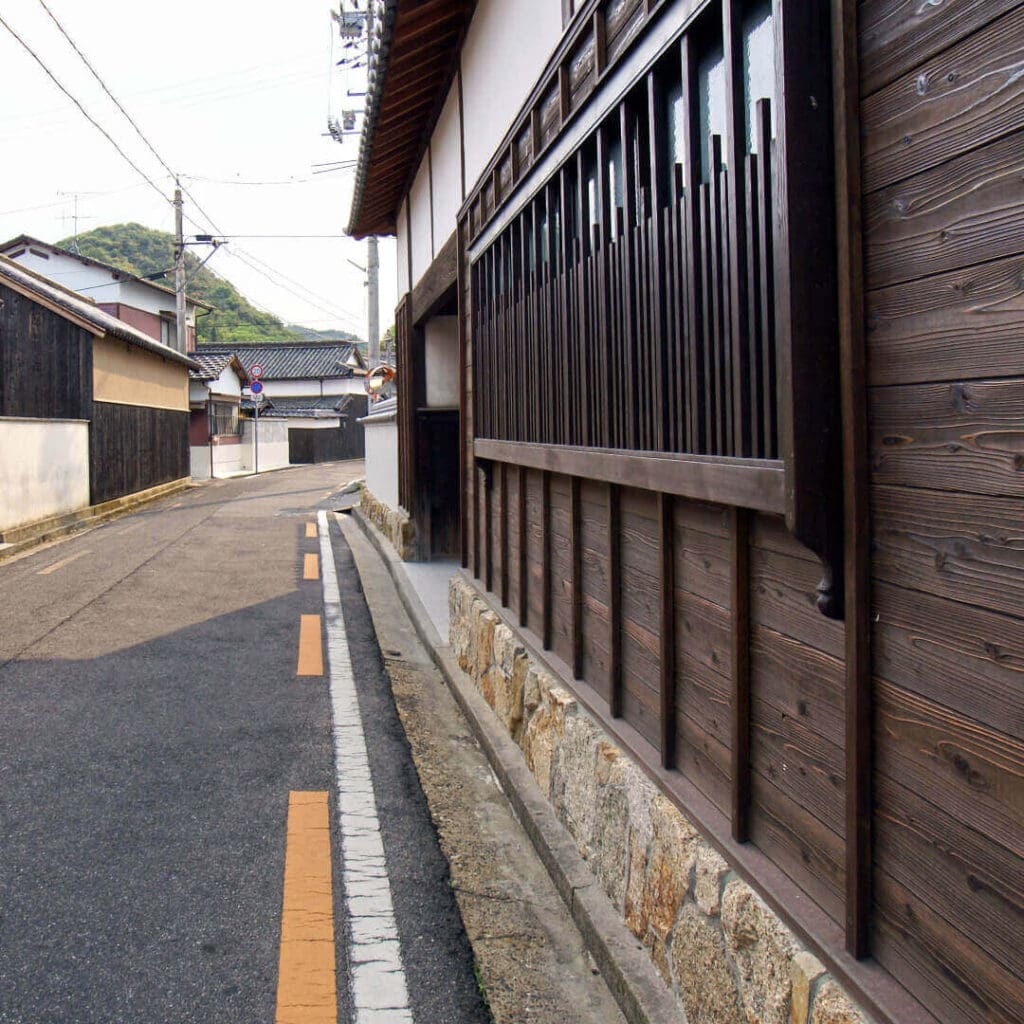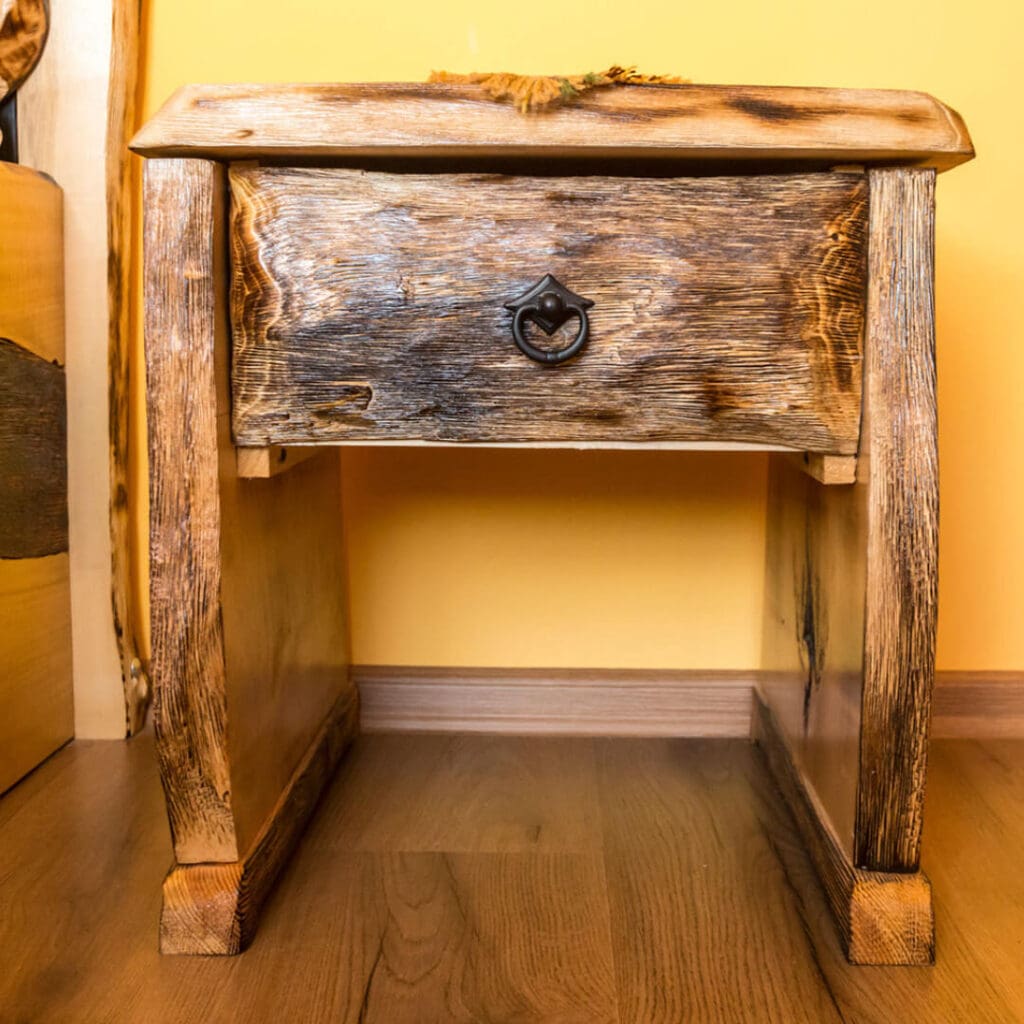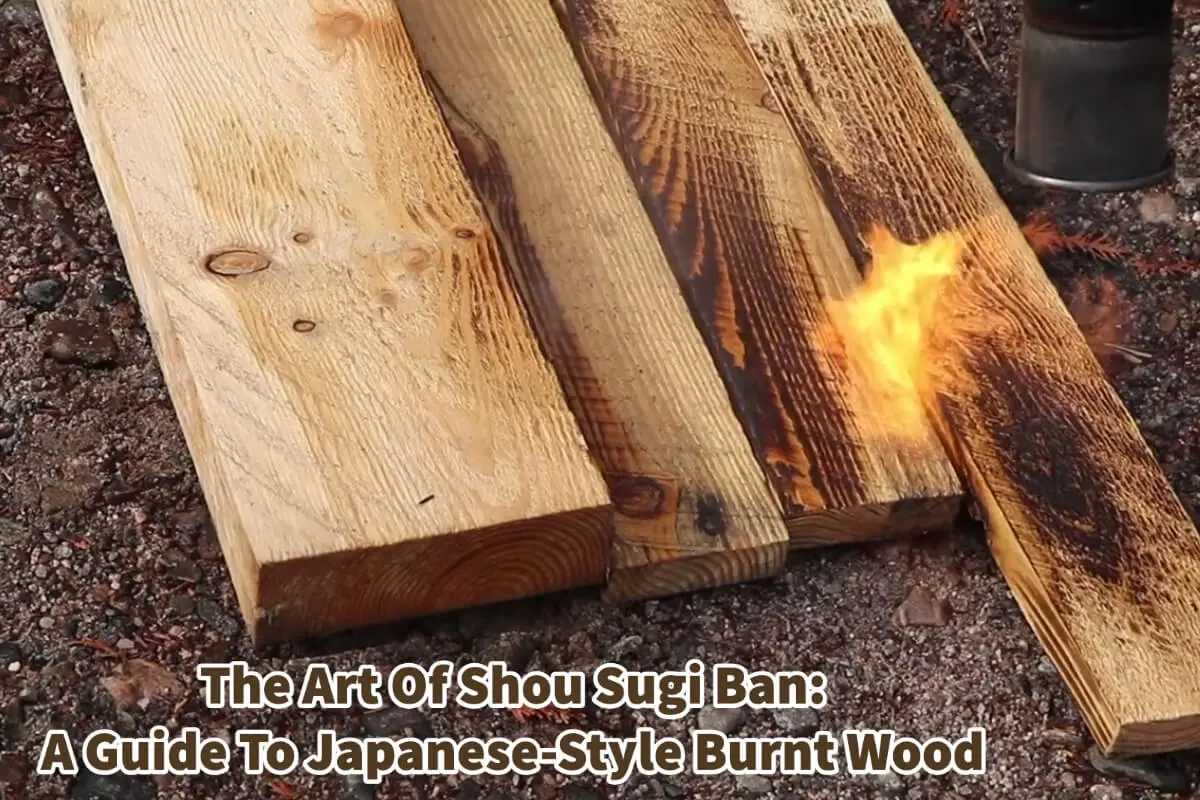I recently fell in love with a Japanese burnt wood look known as Shou Sugi Ban wood. The way the finish is made is unique.
The Japanese Shou Sugi Ban Wood, also known as the Japanese burnt wood, is an ancient Japanese process where the wood’s top surface is burned, and then a beautiful charred layer is revealed underneath the wood with brushing and scraping. The process also ensures the wood is free from insects or rot. Read on to learn more about this unique and wonderful Japanese wood technique.
Table of Contents
- What Is The Japanese Burnt Shou Sugi Ban Wood?
- History Of Japanese Burnt Shou Sugi Ban Wood
- The Japanese Shou Sugi Ban Wood’s Worldwide Appeal
- Frequently Asked Questions
- Related Content
What Is The Japanese Burnt Shou Sugi Ban Wood?
Shou Sugi Ban is a traditional Japanese technique for preserving and finishing wood. The process involves charring the surface of the wood with fire and then brushing or scraping off the charred layer to reveal a unique and durable texture.
The resulting wood is resistant to rot, insects, and fire, making it an ideal choice for siding, flooring, and other exterior applications.
“Shou Sugi Ban” translates to “Burnt Cedar Board” in Japanese, as cedar is the most commonly used wood for this technique.
The charring process creates a layer of carbon on the surface of the wood, which acts as a natural barrier against moisture and pests. The depth of the charred layer can be adjusted to achieve different levels of texture and color.
In addition to its practical benefits, Shou Sugi Ban wood is highly prized for its aesthetic qualities. The charred surface creates a rich, dark color that can range from deep black to warm brown, depending on the type of wood and the intensity of the burn.
That is why not all wood will burn the same for this technique; different woods will give different colors. With the burning process, the texture of the wood is also transformed, with a rough, tactile surface that highlights the natural grain patterns.
Shou Sugi Ban Wood And Look Gains Popularity
Shou Sugi Ban wood has gained popularity recently as a sustainable and eco-friendly alternative to chemically treated lumber. Because the charring process creates a natural protective layer, Shou Sugi Ban wood requires no additional chemicals or preservatives to maintain its durability.

It is also a renewable resource, as cedar and other woods used for Shou Sugi Ban can be sustainably harvested and grown. This makes Shou Sugi Ban wood a unique and versatile material with practical and aesthetic benefits.
Its durability, texture, and natural beauty make it an ideal choice for various exterior and interior applications, from siding and decking to furniture and accent walls.
History Of Japanese Burnt Shou Sugi Ban Wood
Shou Sugi Ban wood originated in Japan hundreds of years ago, where it was used primarily for exterior siding on traditional Japanese homes. The technique was developed to make wood more resistant to fire, insects, and rot, all of which were common problems in the wooden structures of ancient Japan.

Therefore, the Shou Sugi Ban wood is an ancient technique for charring wood that is still being used today.
The Process And Reason For The Japanese Shou Sugi Ban Wood
The charring process used in the Japanese Shou Sugi Ban burnt wood involves burning the surface of the wood until it is charred and blackened, then brushing or scraping off the charred layer to reveal the underlying wood.
This process was discovered to make the wood more resistant to insects and rot, as the charred layer acts as a natural barrier against moisture and pests. It also made the wood more fire-resistant, necessary for buildings when open flames were used for cooking and heating.
So by using this technique, the ancient Japanese discovered that they could make their homes rot and insect-resistant while also helping control the fires for the wooden house structures.
The Unique Aesthetic Qualities Of Japanese Shou Sugi Ban Wood
Over time, the aesthetic qualities of Shou Sugi Ban wood began to be appreciated as well. The dark, rich texture and unique patterns created by the charring process gave the wood a distinctive and striking appearance.

As this is a natural process, each piece of wood may differ. This makes it a complex process to imitate, as each piece of wood is unique during the burning process.
As a result of the process and how unique the wood is, Shou Sugi Ban wood became a practical building material and a sought-after design element in Japanese architecture and design.
The Japanese Shou Sugi Ban Wood’s Worldwide Appeal
Shou Sugi Ban wood is still used extensively in Japan, but its popularity has spread worldwide. Its unique appearance and durability make it a popular choice for everything from exterior siding and decking to interior design elements like accent walls and furniture.

While the technique has evolved to incorporate modern tools and methods, the basic principles of charring and revealing the underlying wood remain the same. The distinctively Japanese look of Shou Sugi Ban wood continues to be admired and sought after by designers and homeowners alike.
A unique aspect of the Shou Sugi Ban Wood is with proper maintenance and care, Shou Sugi Ban treated wood can last up to 100 years! So if you’re looking for a timeless and beautiful way to preserve your wood, look no further than the ancient Japanese technique of Shou Sugi Ban.
We love the look and feel of the Japanese Shou Sugi Ban Wood. There are a lot of applications for not only home exteriors but also home decor and home furnishing designs and products.
If you are interested in seeing how Mondoro can be a valuable partner for you for wood furniture products – we would love to talk to you to see how we can help you.
Find out more about how Mondoro can help you create, develop, and manufacture excellent home decor and furniture products – don’t hesitate to contact me, Anita. Check out my email by clicking here or become a part of our community and join our newsletter by clicking here.
Mondoro gives out a FREE Lookbook to anyone interested. You can receive a copy of our latest Lookbook by clicking here.
Listen to our Podcast called Global Trade Gal. You can find it on all major podcast platforms. Try out listening to one of our podcasts by clicking here.
Subscribe to our Mondoro Company Limited YouTube Channel with great videos and information by clicking here.
Frequently Asked Questions
What is Shou Sugi Ban?
Shou Sugi Ban is a traditional Japanese wood finishing technique that involves charring the surface of wood to create a unique, burnt appearance. The process not only enhances the aesthetic appeal but also provides functional benefits like increased resistance to insects, rot, and weathering.
How is Shou Sugi Ban wood created?
The process begins by burning the wood’s surface, typically using a propane torch or controlled flames. Afterward, the charred layer is revealed through brushing or scraping, creating a distinctive texture. Finally, the wood is treated with natural oils to enhance its durability and appearance.
What types of wood are suitable for Shou Sugi Ban?
While cedar is the traditional choice for Shou Sugi Ban, other softwoods like cypress and pine are also commonly used. Hardwoods such as oak can be used for a different aesthetic. The choice of wood depends on the desired look and the wood’s natural properties.
What are the aesthetic benefits of Shou Sugi Ban?
Shou Sugi Ban provides a range of aesthetic benefits, including a striking burnt appearance, unique textures, and a play of light and shadow on the wood surface. It adds a touch of natural elegance and rustic charm to any space.
Does Shou Sugi Ban increase the wood’s durability?
Yes, the charring process in Shou Sugi Ban enhances the wood’s durability by making it more resistant to insects, decay, and weathering. Additionally, the application of natural oils further protects the wood, extending its lifespan.
Can Shou Sugi Ban be applied to both interior and exterior wood surfaces?
Yes, Shou Sugi Ban is versatile and can be applied to both interior and exterior wood surfaces. The charred finish not only protects the wood but also makes it suitable for various applications, from siding and fencing to furniture and interior paneling.
Is Shou Sugi Ban environmentally friendly?
Shou Sugi Ban can be considered environmentally friendly because it often utilizes sustainably sourced wood, and the traditional process involves minimal chemical use. Additionally, the charred layer can act as a natural barrier, reducing the need for chemical treatments over time.
How does Shou Sugi Ban wood age over time?
Over time, Shou Sugi Ban wood develops a patina that enhances its character. The aging process adds depth to the burnt finish, creating a weathered and timeless appearance. This natural evolution is appreciated by many who choose Shou Sugi Ban for its long-lasting beauty.
Can Shou Sugi Ban be customized for different finishes?
Yes, Shou Sugi Ban can be customized to achieve different finishes and textures. The intensity of the burn, the brushing technique, and the type of natural oils used all contribute to variations in the final appearance. This allows for a wide range of design possibilities.
How should Shou Sugi Ban wood be maintained?
Shou Sugi Ban wood is relatively low-maintenance. Periodic cleaning with a soft brush or cloth, and reapplication of natural oils, can help maintain its appearance and protect the wood. The frequency of maintenance may vary based on environmental factors and the wood’s exposure to the elements.
Related Content
Hardwood Solids Furniture, What Does The Term Mean?
Hardwood solids can include non-solid woods such as engineered woods. Hardwood solids are used in furniture and other industries to classify what wood is used in a product. The terms usually do not classify what type of wood is used.
You can discover more by reading Hardwood Solids Furniture, What Does The Term Mean? by clicking here.
Differences Between Solid Wood, Plywood, Pressboard, And OSB?
Solid wood is wood cut from a tree and made into products; plywood is considered engineered wood. Pressboard is made from paper, including recycled paper. OSB is also known as Oriented Strand Board, and because of its strength is used a lot in roofing, housing, and floors.
You can discover more by reading our blog Differences Between Solid Wood, Plywood, Pressboard, And OSB? by clicking here.
What is Solid Wood vs. Engineered Wood?
Solid wood is cut down from the tree, cut into wood boards, and then used for manufacturing. On the other hand, engineered wood is considered manmade as it is usually manufactured with wood chips, wood shavings, and an adhesive. Today the manufacturing of engineered wood is extremely technical.
You can discover more by reading our blog All About Teak Wood And Outdod? by clicking here.


